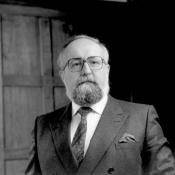 Krzysztof Penderecki (nato il 23 novembre 1933 a Dębica, Polonia) è un compositore polacco contemporaneo la cui opera si colloca nell'ambito del postserialismo.
Krzysztof Penderecki (nato il 23 novembre 1933 a Dębica, Polonia) è un compositore polacco contemporaneo la cui opera si colloca nell'ambito del postserialismo.
La sua sperimentazione sonora destava e desta tuttora scalpore. Viene considerato il musicista di riferimento dell'avanguardia polacca e fra le varie etichette gli è stata assegnata anche quella di "classico postmoderno".
Penderecki è uno dei pochi compositori di musica contemporanea il cui nome sia giunto con successo anche presso il grande pubblico, essendo la sua musica stata usata anche nel film di Stanley Kubrick, Shining. De Natura Sonoris (la composizione usata dal regista) contribuisce notevolmente ad aumentare il clima di tensione e di suspance nel film, grazie ai suoi caratteri striduli e interrotti.
it. wikipedia
*
Krzysztof Penderecki (IPA: [ˈkʂɨʂtɔf pɛndɛrˈɛ͡tski], born November 23, 1933 in Dębica) is a Polish composer and conductor of classical music.
After taking private composition lessons with Franciszek Skolyszewski, Penderecki studied music at Krakow University and the Academy of Music in Krakow under Artur Malawski and Stanislaw Wiechowicz. After graduating in 1958, he took up a teaching post at the Academy.
Penderecki's early works show the influence of Anton Webern and Pierre Boulez (he has also been influenced by Igor Stravinsky). Penderecki's international recognition began in 1959 at the Warsaw Autumn Festival with the premieres of the works Strophen, Psalms of David, and Emanations, but the piece that truly brought him to international attention was Threnody to the Victims of Hiroshima (see threnody and Hiroshima), written for 52 string instruments. In it, Penderecki makes use of extended instrumental techniques (for example, playing on the "wrong" side of the bridge, bowing on the tailpiece). There are many novel textures in the work, which makes great use of tone clusters (notes close together played at the same time). See sound mass. The work was originally titled 8' 37", perhaps in a nod to John Cage, but Penderecki changed the title after his publisher suggested he give it a more colorful name.
The St. Luke Passion (1963–66) brought Penderecki further popular acclaim, not least because it was a major, devoutly religious work, written in an avant-garde musical language, composed within Communist Eastern Europe. Western audiences saw it as a snub to the Soviet authorities and were keen to give it their support. Various different musical styles can be seen in the piece. The experimental textures, such as were seen in the Threnody, are balanced by the baroque form of the work and the occasional use of more traditional harmonic and melodic writing. Penderecki makes use of serialism in this piece, and one of the tone rows he uses includes the BACH motif, which acts as a bridge between the conventional and more experimental elements. The Stabat Mater section towards the end of the piece concludes on a simple major chord of D major, and this gesture is repeated at the very end of the work, which finishes on a triumphant E major chord. These are the only tonal harmonies in the work, and both come as a surprise to the listener; Penderecki's use of tonal triads such as these remains a controversial aspect of the work.
Around the mid-1970s, while he was a professor at the Yale School of Music [1] Penderecki's style began to change. The Violin Concerto No. 1 largely leaves behind the dense tone clusters with which he had been associated, and instead focuses on two melodic intervals: the semitone and the tritone. Some commentators went so far as to compare this new direction to Anton Bruckner.
This direction continued with the Symphony No. 2, Christmas (1980), which is rather straightforward from a harmonic and melodic standpoint for a composer who had been one of the most experimental in Europe. It makes frequent use of the tune of the Christmas carol, Silent Night.
In 1980, Penderecki was commissioned by Solidarity to compose a piece to accompany the unveiling of a statue at the Gdańsk shipyards to commemorate those killed at anti-government riots there in 1970. Penderecki responded with the Lacrimosa, which he later expanded into one of the best known works of his later period, the Polish Requiem (1980-84, revised 1993). Here again the harmonies are quite lush, although there are moments which evoke his earlier work in the 1960s. The tendency in recent years has been towards more conservative romanticism, however, as seen in works like the Cello Concerto No. 2 and the Credo.
Some of Penderecki's music has been adapted for film soundtracks. Portions of the 1971 Cello Concerto have been used in both The Shining and The Exorcist. In 1991 the Manic Street Preachers used a sample of Threnody To The Victims Of Hiroshima in the intro of their single You Love Us (Heavenly Version). More recently, director David Lynch made extensive use of Penderecki's music in his 2006 film Inland Empire. Kosmognia also features on the soundtrack to Lynch's 1990 film Wild at Heart .
In 2001, Penderecki was awarded with the Prince of Asturias Prize in Spain, one of the highest honours given in Spain to individuals, entities, organizations or others from around the world who make notable achievements in the sciences, arts, humanities, or public affairs.
Penderecki received an honorary doctorate from the University of Münster, Germany in 2006.
His notable students include Chester Biscardi.